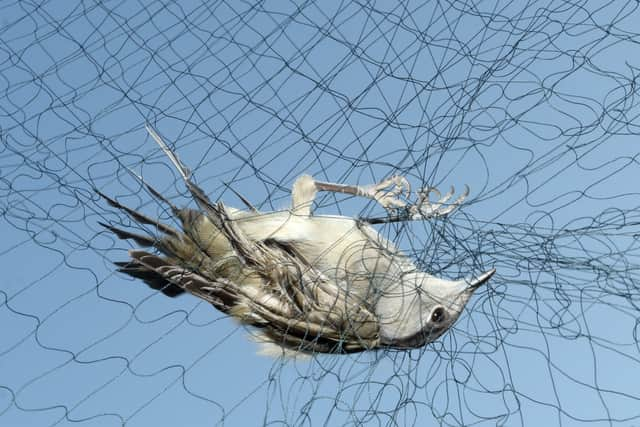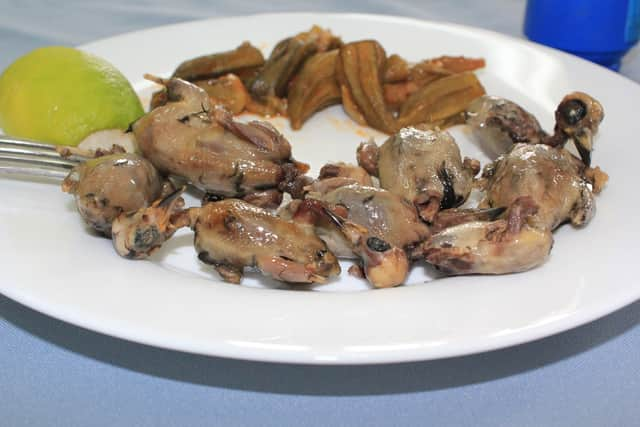What is 'ambelopoulia?' Concern as over 400,000 songbirds trapped and killed for controversial dish last year
and live on Freeview channel 276
A new report has found 90,000 more migrating songbirds were trapped and killed in Cyprus last autumn than the year before - to make an illegal and controversial dish.
On Wednesday (6 March), wildlife charities BirdLife Cyprus, the Royal Society for the Protection of Birds (RSPB) and the Committee Against Birds Slaughter (CABS), released their latest autumn trapping report. They found that the number of songbirds illegally killed in their monitoring area has experienced a recent spike, with 435,000 recorded in autumn 2023 - up from 345,000 in 2022.
Advertisement
Hide AdAdvertisement
Hide AdThe island is an important part of the autumn migration route for many songbird species - including robins, blackcaps, and garden warblers - who use it as a stepping stone as they travel between their breeding grounds in Europe to their warmer over-wintering grounds in Africa. Unfortunately, the presence of so many amazing birds also attracted criminal elements, the charities said in a statement, who sold them via the black market to restaurants, to make an expensive local delicacy called ‘ambelopoulia’.
Before international wildlife charities teamed up with Cypriot authorities 20 years ago, more than two million birds were thought to be caught every year. But although the partnership has seen "a massive reduction" in the number of traps being detected and birds being killed, the latest figures pointed to a worrying trend.


The report estimated that 4.69 kilometres of mist nets were used in the survey area last autumn - an increase of 41% across the British sovereign base areas. This suggested an increase of about 6% across the entire island compared to 2022. However, this was still a decrease of 88% since 2002, the charities said, which showed that the partnership worked, so long as there was enough enforcement in place.
While it welcomed the Cyprus Police Anti-Poaching Unit being brought back last year, after it was abolished in 2019, the report noted that the level of enforcement work undertaken last autumn against bird trappers was "very disappointing". Mark Thomas, head of RSPB investigations, said: "For two decades our international partnership has shown that we can work together to tackle this criminal activity through direct action on the ground backed up by enforcement action. However, this autumn shows that more still needs to be done, particularly in the Republic of Cyprus.
Advertisement
Hide AdAdvertisement
Hide Ad"We cannot allow the progress we have made to be undone and the shocking levels of songbird killings to return to the abhorrent levels we once saw," he continued. Mr Thomas called for more police resourcing in Britain's overseas territories in Cyprus, as well as renewed commitment from the Republic of Cyprus' government to tackle organised trappers, "who continue making huge profits for little risk".
"By working together we can make this a thing of the past," he added. BirdLife Cyprus director, Martin Hellicar, said the latest autumn's results showed how quickly years of progress could be reversed, if enforcement resources were not maintained.
"Within the Republic of Cyprus, despite the decrease in bird trapping levels, we recorded an increase in organised trapping. This is very concerning, and we expect the re-instated Cyprus Police Anti-poaching unit to take a more active role in tackling organized trappers, in collaboration with the Game and Fauna Service," he said.


BirdLife Cyprus has been growing its outreach and awareness campaigning too, he continued, hoping "to achieve a change in the hearts and minds of the local culture, from eating [songbirds] to protecting and appreciating them". Mr Hellicar said: "This is an even greater challenge to overcome, but we are committed to continuing and confident that eventually we will see a positive behavioural change in favour of bird conservation."
What is ambelopoulia?
Advertisement
Hide AdAdvertisement
Hide AdAmbelopoulia is a traditional Cypriot dish of pickled songbirds, which are then roasted or grilled. Because the species used are so small, their beaks, bones, and entrails are not typically removed, and they are usually eaten whole.
The dish, and trapping birds in order to make it, were banned in Cyprus in 1974. However, it is still found in many restaurants, and some people still make it at home, using songbirds which have been illegally poached. BirdLife reports that many are reluctant to give up the dish, which has been a traditional foodstuff for many years.
How are the birds being caught?
In a "huge" operation, often linked to organised crime, gangs will use electronic decoys to lure birds into hard-to-see 'mist nets', placed between acacia bushes and in orchards. Birds will become badly tangled in these nets as they fly through, and trappers are able to come back and gather them up later.
They are also known to use sticky birdlime sticks planted in trees and bushes, to catch birds as they hop between branches. Both methods are illegal in Cyprus, and BirdLife Cyprus says they are also indiscriminate - meaning many species, including protected ones, can become trapped. The charity has recorded some 157 different species caught in traps over the years, including the island's three endemic species, the Cyprus warbler, the Cyprus Wheatear, and even the Cyprus Scops Owl.
Advertisement
Hide AdAdvertisement
Hide AdA recent United Nations report found that nearly half of all the world's migratory animals are falling in numbers, with more than one in five (22%) of the 1,189 species listed already facing extinction. The report listed two main threats to all migratory animals; overexploitation - including both intentional hunting and fishing, and ending up as accidental bycatch - and habitat loss due to human activity.
Comment Guidelines
National World encourages reader discussion on our stories. User feedback, insights and back-and-forth exchanges add a rich layer of context to reporting. Please review our Community Guidelines before commenting.
